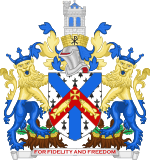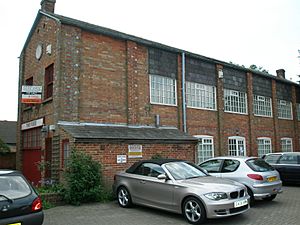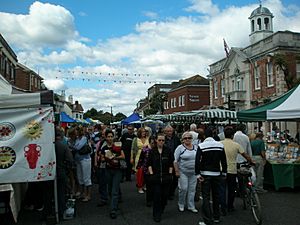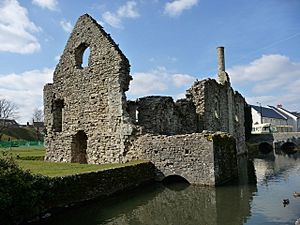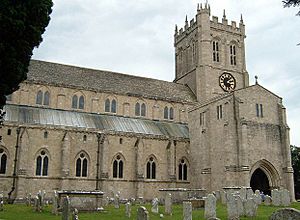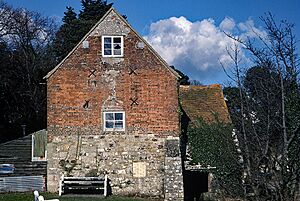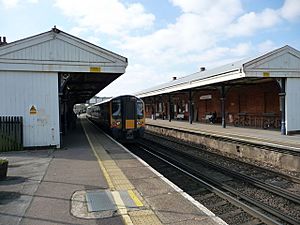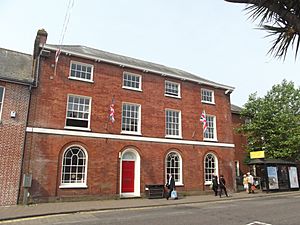Christchurch, Dorset facts for kids
Quick facts for kids
Christchurch
|
||
|---|---|---|
|
Town and civil parish
|
||

Christchurch Priory, the longest parish church in England
|
||
|
||
| Motto(s):
'For Fidelity and Freedom'
|
||
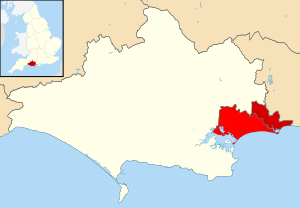
Location of former Christchurch borough (dark red) within Bournemouth, Christchurch and Poole (red)
|
||
| Sovereign state | United Kingdom | |
| Constituent country | England | |
| Region | South West England | |
| Ceremonial county | Dorset | |
| Historic county | Hampshire | |
| Unitary authority | Bournemouth, Christchurch and Poole | |
| Government | ||
| • Type | Borough council | |
| • Body | Bournemouth, Christchurch and Poole Council | |
| Area | ||
| • Total | 19.5 sq mi (50.4 km2) | |
| Population | ||
| • Total | 31,372 (2,021 Census) | |
| • Density | 2,350/sq mi (909/km2) | |
| Time zone | UTC+0 (Greenwich Mean Time) | |
| Postcode |
BH23
|
|
| Post town |
christchurch
|
|
| Area code(s) | 01202 01425 |
|
| ISO 3166-2 | GB-DOR (Dorset) | |
| ONS code | 19UC (ONS) E07000048 (GSS) |
|
| OS grid reference | SZ156923 | |
| Website | Town Council | |
Christchurch is a town on the south coast of Dorset, England. In 2021, about 31,372 people lived there. It's next to Bournemouth and close to the New Forest. Christchurch was once part of Hampshire. From 1974 to 2019, it was a special area called a borough. Now, it's part of the new Bournemouth, Christchurch and Poole council.
The town started in the 7th century where the Avon and Stour rivers meet, flowing into Christchurch Harbour. It was first called Twynham. Later, it became Christchurch after a large church, the priory, was built in 1094. The town grew into an important trading port. It was protected by walls in the 9th century. More defenses, like a castle, were added in the 12th century. This castle was later destroyed during the English Civil War. In the 1700s and 1800s, smuggling was a big business here. During Second World War, Christchurch was heavily protected. An Airspeed factory was built in 1940 to make planes for the Royal Air Force.
Today, Christchurch is a popular place for tourists. People enjoy its harbour, beaches, nature areas, and old buildings. Bournemouth Airport, a busy international airport, is nearby. The airport's business park has many companies that work with planes and engineering. It is one of the biggest job sites in Dorset.
Contents
- History of Christchurch: A Journey Through Time
- Geography: Exploring Christchurch's Natural Beauty
- Demography: Who Lives in Christchurch?
- Economy: How Christchurch Makes Money
- Culture: Fun Things to Do in Christchurch
- Religion
- Landmarks: Historic Places to See
- Sport and Recreation: Staying Active in Christchurch
- Transport: Getting Around Christchurch
- Education: Schools in Christchurch
- Notable Residents: Famous People from Christchurch
- Twin towns
- See also
History of Christchurch: A Journey Through Time
Christchurch began around 650 AD. Missionaries from St Birinus came to Wessex and settled between the Avon and Stour rivers. These rivers were important for trade. Boats could travel up the Avon to places like Salisbury. The town was called Tweoxneam in 901, meaning "between rivers." Around 890 AD, Alfred the Great saw how important Twynham was. He made it a burh (a fortified town) to protect it from Danes. In 1094, Ranulf Flambard started building a large church, the priory. After the priory was built, the town became known as Christchurch.
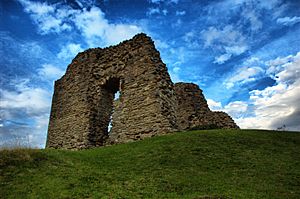
A castle was built in the town in the early 12th century. It was first a wooden fort, then rebuilt with stone by Baldwin de Redvers. The castle was used during the English Civil War. It changed hands several times between the Parliamentarians and Royalists. In 1652, Oliver Cromwell ordered the castle to be destroyed. He didn't want it to fall into Royalist hands again.
Even though fishing was important, the harbour became harder for large ships to use. Sandbars at the entrance often shifted. In 1665, Edward Hyde, Earl of Clarendon tried to fix the harbour. He cut a new entrance, but it kept silting up. A big storm in 1703 blocked it completely. For 150 years, people tried to find solutions, but none worked.
Smuggling was a very profitable business in Christchurch during the 1700s and 1800s. It was easy to move goods to nearby towns. The difficult harbour entrance also made it hard for customs boats to catch smugglers. Many people in town were involved. In 1784, a fight between smugglers and Customs officers happened. It was called the Battle of Mudeford. A Royal Navy officer was killed, and a smuggler was later executed.
Another important industry was making fusee chains for watches. In 1790, Robert Cox started making these chains. By 1793, his company had a monopoly in Britain. In 1845, William Hart opened another factory. But by 1875, watch designs changed, and the factories closed.
The railway came to Christchurch in 1847. The first station was at Holmsley, and people took a bus to town. In 1862, a new station was built closer to town. Christchurch became part of the main railway line in 1883. This made it easier for tourists to visit. A power station was built in 1903 to power public trams. It also provided electricity for the town.
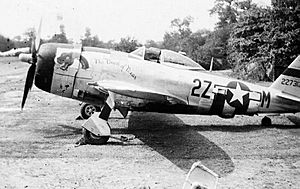
In 1930, the Fisher Aviation Company started offering flights from Somerford Road. By 1933, they had flown over 19,000 passengers. In 1934, they got permission to build an aerodrome, which became Christchurch Airfield. During World War II, an Airspeed factory was built there to make planes for the RAF. The USAAF also had a base there in 1944. Another airport, Hurn, opened in 1944 and later became Bournemouth Airport.
In 1940, Christchurch was made into an "anti-tank island" to prepare for a possible invasion. They built pillboxes, gun spots, and tank traps. Between 1941 and 1942, Donald Bailey invented the Bailey bridge at the Christchurch Barracks.
The town grew a lot from the mid-1700s. In 1873, a large area of land called Portfield was built on. The town's population quickly increased. In the 1900s, the population grew from 11,000 to over 45,000. A large housing area was built in the 1950s. In 1958, a bypass was built to redirect traffic away from the town centre. In 1974, Christchurch became part of Dorset and was given borough status.
Geography: Exploring Christchurch's Natural Beauty
Christchurch is the most eastern coastal town in Dorset. It's next to Bournemouth and about 9 miles (14 km) east of Poole. The town centre is between the Avon and Stour rivers. These rivers flow into Christchurch Harbour. The town's area reaches to Hurn Forest in the north, including Bournemouth Airport, and east along the coast to Walkford.
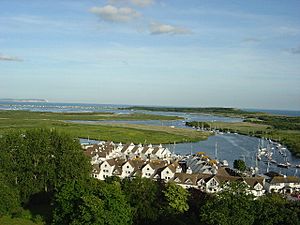
Christchurch Harbour has large areas of salt marsh (land flooded by salty water). It's protected by a sandbar called Mudeford Spit. This spit has sandy beaches and beach huts. The harbour is also protected by Hengistbury Head, a natural headland. This area is special for sand martins, which nest in the sandy cliffs. Only shallow boats can enter the harbour because of the sandbars. The entrance, called the Run, has Mudeford Quay on one side and the spit on the other. Strong tides flow here. The harbour is a safe place for wildlife, with many swans and other birds. Hengistbury Head was home to the earliest settlements, dating back to the Bronze Age.
Stanpit Marsh is a 65-hectare (160-acre) nature reserve where the Avon and Stour rivers meet. In the 1700s, smugglers used its narrow channels. It has salt marsh and freshwater marsh with reed beds. You can see grazing horses, rare birds, and special plants here. It became a Local Nature Reserve in 1964.
North of Christchurch is St Catherine's Hill. It's the highest point in the area, at 53 metres (174 ft) above sea level. This hill has heathland and pine forests. From here, you can see the New Forest, Christchurch Priory, and the Isle of Wight. People have used St. Catherine's Hill as a lookout and beacon since ancient times. It was also a military training ground. Rare wildlife, like the Dartford warbler and sand lizard, live on the hill.
The ground in Christchurch is mostly sand with some clay. The top layer is sand and gravel. Sand and gravel are dug up for building here.
Climate: Christchurch Weather
Christchurch has a mild climate, like the rest of the UK. Temperatures don't change much between day and night or throughout the year. The Gulf Stream helps keep the weather mild. Because Christchurch is on the south coast, its winters are a bit warmer and summers a bit cooler than places further inland.
The warmest months are July and August, with temperatures usually between 12°C and 22°C (54°F to 72°F). The coolest months are January and February, with temperatures from 2°C to 8.3°C (36°F to 47°F). The average yearly rainfall is 594.5 mm (23.4 inches), which is less than the UK average.
| Climate data for Christchurch, Dorset, England | |||||||||||||
|---|---|---|---|---|---|---|---|---|---|---|---|---|---|
| Month | Jan | Feb | Mar | Apr | May | Jun | Jul | Aug | Sep | Oct | Nov | Dec | Year |
| Mean daily maximum °C (°F) | 8 (46) |
8 (46) |
11 (52) |
13 (55) |
17 (63) |
19 (66) |
22 (72) |
22 (72) |
19 (66) |
15 (59) |
11 (52) |
9 (48) |
14.5 (58.1) |
| Mean daily minimum °C (°F) | 2 (36) |
2 (36) |
3 (37) |
4 (39) |
7 (45) |
10 (50) |
12 (54) |
12 (54) |
10 (50) |
7 (45) |
4 (39) |
3 (37) |
6.3 (43.3) |
| Average precipitation mm (inches) | 62.9 (2.48) |
50.3 (1.98) |
40.7 (1.60) |
45.5 (1.79) |
29.2 (1.15) |
35.6 (1.40) |
31.8 (1.25) |
35.5 (1.40) |
51.5 (2.03) |
75.3 (2.96) |
69.0 (2.72) |
67.2 (2.65) |
594.5 (23.41) |
| Source: MSN | |||||||||||||
Green Belt: Protecting Nature Around Christchurch
Christchurch is in a green belt area. This is a special protected zone around towns. Its purpose is to stop towns from growing too much and merging together. It also helps keep the countryside natural and protects the unique feel of smaller communities. Building in these areas is limited.
The green belt covers about 3,477 hectares (8,592 acres). It's mostly north of Christchurch, but also surrounds parts of the town. Some areas like Jumpers Common and Bournemouth Airport are not in the green belt. However, most rural parts of the Hurn and Burton areas are included.
Important natural places in the green belt include the rivers Stour, Moors, and Avon. Their floodplains are also protected. Other features are Christchurch Priory, Blackwater and St Catherine's hills, Hurn Forest, Stanpit Marsh, and Mudeford Spit. The New Forest National Park is next to the green belt on the east side.
Demography: Who Lives in Christchurch?
| Age | Percentage |
|---|---|
| 0–15 | 15.8 |
| 16–17 | 2.0 |
| 18–44 | 27.1 |
| 45–59 | 19.1 |
| 60–84 | 31.9 |
| 85+ | 4.1 |
In 2021, the Christchurch parish had a population of 31,372 people. The wider area had about 50,000 people. This makes it the fourth largest town in Dorset. Christchurch is part of a larger urban area called the South East Dorset conurbation, which has over 400,000 people.
Christchurch has one of the oldest populations in the UK. Many residents are older citizens. About 30.4% of the population is over 65 years old. This is almost double the national average of 16.5%. The area of Highcliffe has the highest percentage of elderly residents in the whole United Kingdom, at 69%. Experts predict that by 2031, about 37.9% of residents will be over 65. In 2005, women in Christchurch lived to about 83.4 years, and men to 79.7 years.
Most people in Christchurch (96.83%) consider themselves White British. Other white groups make up 2.09%. People of mixed race are 0.44%. Asian people are 0.25%, Chinese 0.16%, and black people 0.13%.
More than half of the working population (55%) have full-time jobs. Another 22% work part-time. Many residents (over 40%) have jobs that need high skills. About 16.63% have a university degree or higher qualification.
Christchurch has around 22,800 homes.
| Historical population of Christchurch | |||||||||||
| Year | 1801 | 1811 | 1821 | 1831 | 1841 | 1851 | 1861 | 1871 | 1881 | 1891 | 1901 |
|---|---|---|---|---|---|---|---|---|---|---|---|
| Population | 265 | 230 | 317 | 359 | 1,317 | 1,332 | 3,460 | 5,589 | 7,717 | 14,686 | 11,155 |
| Year | 1911 | 1921 | 1931 | 1941 | 1951 | 1961 | 1971 | 1981 | 1991 | 2001 | 2011 |
| Population | 8,496 | 11,572 | 15,773 | 18,828 | 22,475 | 27,549 | 33,768 | 37,285 | 41,240 | 44,869 | – |
| Census: 1801 – 2001 | |||||||||||
Economy: How Christchurch Makes Money
| Sector | 2000 | 2004 | 2007 | Change
(£M) |
Change
(%) |
|---|---|---|---|---|---|
| Agriculture | 10.5 | 14.6 | 16.3 | 5.9 | 56% |
| Mining/Quarrying | 0.0 | 0.0 | 0.0 | 0.0 | 0.0% |
| Food/Textiles/Wood | 6.9 | 4.3 | 4.0 | −2.9 | −42% |
| Printing and Publishing | 3.7 | 3.9 | 3.0 | −0.7 | −19% |
| Chemicals and Minerals | 10.2 | 6.7 | 7.4 | −2.8 | −28% |
| Metals and Engineering | 12.8 | 26.9 | 30.8 | 17.9 | 140% |
| Electronics | 56.8 | 34.7 | 40.5 | −16.2 | −29% |
| Transport equipment | 52.7 | 62.4 | 71.6 | 18.8 | 36% |
| Manufacturing nes | 3.5 | 4.7 | 3.2 | −0.3 | −8% |
| Electricity/Gas/Water | 12.5 | 14.9 | 20.7 | 8.2 | 66% |
| Construction | 34.7 | 49.6 | 43.5 | 8.8 | 25% |
| Distribution | 73.5 | 104.2 | 110.8 | 37.4 | 51% |
| Hotel and Catering | 21.5 | 27.0 | 34.3 | 12.8 | 60% |
| Transport and Communications | 80.5 | 119.9 | 145.1 | 64.6 | 80% |
| Banking and Insurance | 15.2 | 20.1 | 25.5 | 10.3 | 68% |
| Other business services | 57.8 | 56.2 | 84.8 | 27.0 | 47% |
| Public administration and Defence | 9.8 | 13.2 | 16.5 | 6.7 | 68% |
| Education and Health | 67.2 | 70.7 | 76.8 | 9.6 | 14% |
| Miscellaneous services | 22.9 | 20.4 | 22.3 | −0.6 | −2% |
| Total GVA | 552.5 | 664.5 | 757.0 | 204.5 | 37% |
Between 2000 and 2007, the total value of goods and services produced in Christchurch grew by 37%. It went from £552 million to £757 million. The biggest part of the local economy was transport and communication. This sector brought in £145 million in 2007. The metals and engineering sector grew the most, by 140%.
An aircraft factory was built in Christchurch in 1942 by Airspeed Ltd.. In 1948, it became part of de Havilland and made planes like the Vampire. In the 1950s, Bournemouth Airport also started making aircraft. Even though these factories closed later, aircraft and engineering are still important for the local economy. Some big employers in Christchurch include BAE Systems and Honeywell.
Christchurch High Street has 48 shops. The Saxon Square shopping area, built in 1982, added even more shops. This makes Christchurch the fifth largest shopping centre in Dorset.
In 2008, about 837,000 people stayed overnight in Christchurch. Another 792,000 visited for the day. Tourism brought in £76 million for the local economy. Christchurch has 11 caravan and camping parks. It also has about 900 beds in hotels and guest houses.
Culture: Fun Things to Do in Christchurch
Christchurch has had a weekly market since 1149. It used to be at the corner of Castle Street and High Street. The market stopped in 1872 but started again a century later. Today, it's held every Monday on High Street, which is closed to traffic then. Sometimes, there are special food fairs or a French market.
Every May since 2000, Christchurch has a food and wine festival. It has over 100 stalls selling food and drinks. There's a big tent in Saxon Square where chefs give cooking demonstrations. Famous chefs like Gary Rhodes have been guests. The festival teaches people about healthy eating and different foods. Local chefs visit schools during the festival. There are also cooking workshops for kids.
Christchurch also has an annual music festival in early July. It started as a folk festival but now includes many types of music. You might see clog and morris dancing groups, or salsa and belly dancing. Rock bands and soul groups also play. The festival usually takes place on the town quay. Local bars often have smaller bands.
Another yearly event is the regatta, which has happened every year since 1909. It's usually in the second week of August. There are rowing races on the River Stour. A travelling funfair is set up on the town quay. A carnival parade and a big firework display happen on the weekend. The part of the quay near the priory is called The Quomps. A 19th-century bandstand there was a gift to the town in 1938. In summer, it hosts free outdoor concerts on Saturdays. One popular event is "Stompin' on the Quomps," a smooth jazz festival. Brass bands often play there on Sunday afternoons.
The town has a museum called the Red House Museum. It used to be the town's workhouse. The museum has exhibits about local history, old clothes, geology, nature, and archaeology. It also has beautiful gardens.
Religion
Christchurch has many churches. The most famous is Christchurch Priory.
Landmarks: Historic Places to See
Town Centre: A Mix of Old and New
Christchurch town centre has old pubs, restaurants, coffee shops, and historic buildings. The oldest part of town dates back to Saxon times. The Mayor's Parlour was built in 1745 as a market hall. It was moved in 1849 and used as the town hall. It was restored around 1982 when the Saxon Square shopping area was built.
High Street has two old pubs: Ye Olde George Inne and the Ship Inn. The Ship Inn has the oldest licence in Christchurch and was a place where smugglers used to meet. Its history goes back to 1688. Church Street has Church Hatch, a beautiful Georgian house. It was saved from being torn down in 1929. Ye Olde Eight Bells, now a gift shop, was another pub popular with smugglers. The Perfumery, a 14th-century thatched building, is thought to be an old courthouse.
The town centre has three historic bridges. The Town Bridge is a 15th-century stone bridge. It crosses two parts of the River Avon. The Waterloo Bridge, built around 1816, crosses the larger part of the Avon. It's made of Portland stone and has five wide arches. A modern walkway for people is attached to it.
Christchurch Castle: A Ruined Stronghold
The Christchurch Castle is from Norman times. It was first a motte and bailey castle (a mound with a fenced area). The castle used to be very important, but now it's in ruins. Only parts of the keep (main tower) walls are left. A castle has been in Christchurch since about 924 AD. Edward the Elder first built a wooden fort here. After the Norman conquest in 1066, the castle was made stronger with a ditch and a wooden fence. Later, a stone keep was built in the 12th century.
Inside the castle walls is the Constable's House. This is a Norman home. Many of its stone parts are still there. It has a rare Norman chimney and a toilet that hangs over the mill stream. The castle was destroyed by the Parliamentary army during the English Civil War. This was to stop it from being used by the Royalists.
Christchurch Priory: England's Longest Parish Church
The 11th-century Christchurch Priory overlooks Christchurch town centre and the harbour. It was once a monastery. In 1540, Henry VIII gave it to the town to be used as a parish church. It is the longest parish church in England. Its nave (main part) is over 311 feet (95 m) long. The nave and transepts (side parts) are Norman style, with thick columns and round arches. The lady chapel is from the 14th century and has a more Perpendicular style. The large choir was rebuilt in the 16th century. The Priory is famous for its Miraculous Beam, which attracts visitors. Inside the Priory grounds is Priory House, a large house built in 1777. The Priory is still used for church services today.
Place Mill: An Ancient Watermill
Place Mill is an old watermill from Anglo-Saxon times. It's located near the Priory on Christchurch Quay. The mill is mentioned in the Domesday Book. It has a medieval stone base with red brickwork on top. The mill belonged to the Priory. It stopped working in 1908 and was empty until the council bought and restored it in 1981. It's special because it takes water from one river (the Avon) and lets it flow into another (the Stour). A millstream flows from the Royalty Fisheries to the mill. A medieval bridge called Place Mill Bridge crosses this stream nearby.
Sport and Recreation: Staying Active in Christchurch
Christchurch's football team, Christchurch F.C., plays at Hurn Bridge Sports Club. The club started in 1885. They were champions and moved up to Hampshire League One in 1938, 1948, and 1986. In 1970, they were the first team to win the Bournemouth Senior Cup three times in a row. The club joined the Wessex League in 1988.
Hurn Bridge is also home to Christchurch Cricket Club. They have teams in the Saturday and Sunday Dorset Leagues. In 2009, their first team won Division 3. Hurn Bridge also has the Dorset Cricket Centre, an indoor training place.
Christchurch has a leisure centre with a swimming pool and a golf course. It also has an indoor bowling area. Christchurch has a lawn bowling club near the castle ruins. There are two other lawn bowling clubs and golf courses in Iford and Highcliffe.
Sailing is very popular in Christchurch. The harbour has three sailing clubs: Highcliffe Sailing Club, Mudeford Sailing Club, and Christchurch Sailing Club. The local rowing club is also on the Town Quay.
Transport: Getting Around Christchurch
Christchurch railway station is on the South West Main Line. Trains are run by South Western Railway. Usually, there's one train an hour to London Waterloo, Bournemouth, Poole, and Weymouth. There are also trains from Bournemouth to Winchester and from Southampton Central to Bournemouth.
Christchurch is on the A35 road, which goes from Devon to Southampton. North of town, the A35 connects to the A31. This road leads to the M27 motorway at Southampton. The A338 road goes north from Bournemouth through Christchurch to Ringwood.
Buses are run by Go South Coast under their Morebus name. Buses connect Christchurch to Bournemouth, Lymington, New Milton, Ringwood, and Somerford.
Bournemouth Airport is about 3.75 miles (6 km) north-west of Christchurch town centre. It used to be an RAF airfield. Commercial flights started in the late 1950s. In 2019, about 800,000 passengers used the airport. Ryanair, TUI, and EasyJet fly from here to places in Europe.
In summer, small passenger ferries travel between Tuckton and Mudeford Spit. They stop at the town quay. Another ferry crosses the Stour river between Wick and the Quay. This ferry was running before the bridge was built in 1882. A third ferry crosses the harbour entrance from Mudeford Sandbank to Mudeford Quay. This ferry used to be operated by rowing boats until the 1960s.
Education: Schools in Christchurch
Christchurch has two infant schools, two junior schools, and five primary schools (which combine infant and junior). It also has three secondary schools: Twynham School (1,515 students), Highcliffe School (1,347 students), and the Grange School (637 students). The secondary schools share a sixth form, offering different courses at each location.
Since April 1, 2019, schools in Christchurch are managed by the Bournemouth, Christchurch and Poole Council.
Notable Residents: Famous People from Christchurch

- Benjamin Ferrey: An architect who helped restore Christchurch Priory.
- Edmund Lyons, 1st Baron Lyons: An admiral and diplomat born in Burton.
- Gustavus Brander: A curator at the British Museum and governor of the Bank of England. He built Priory House in 1777.
- Prince Louis Phillipe: The future King of France, who stayed here during the Napoleonic Wars.
- Robert Southey: A writer and Poet Laureate who lived in Burton from 1797 to 1799.
- John Stuart, 3rd Earl of Bute: A Prime Minister (1762–63) and botanist. He helped start Royal Botanic Gardens, Kew. He built a mansion in Christchurch in 1773.
- Charles Stuart, 1st Baron Stuart de Rothesay: A diplomat and grandson of John Stuart. He built Highcliffe Castle.
- Sir George Rose: A Member of Parliament for Christchurch and friend of Prime Minister William Pitt. He built a home called 'Sandhills' at Mudeford.
- Field Marshal Hugh Rose, 1st Baron Strathnairn: Son of Sir George Henry Rose, he lived at the family home.
- James Clark: A horticulturist (plant expert) who created new potato types. He was born and lived his whole life near Christchurch.
- Donald Bailey: A civil engineer who invented the Bailey bridge. He lived in Christchurch from 1966 to 1985.
- Bob Wilson: A famous Arsenal and Scotland goalkeeper. He has a home near the town centre.
Twin towns
Christchurch is connected with these towns:
- Aalen, Germany
- Tatabánya, Hungary
- Christchurch, New Zealand
- Saint-Lô, France
See also
 In Spanish: Christchurch (Dorset) para niños
In Spanish: Christchurch (Dorset) para niños


